
wellness
Ayurveda is the principal health system in India, but other forms— such as Unani, Siddha and Tibetan medicine are also practiced. This chapter considers all these, along with many specific therapies from each. A variety of therapeutic massages is covered, as well as heat and steam therapies, and more obscure treatments for eye or skin health. All are geared towards detoxification, both internal and external, with the ultimate aim being good health, longevity and spiritual enrichment.
abhyangam
Traditional Ayurvedic Massage
The Charaka Samhita, one of the foremost Ayurvedic texts, advises that every person should have an Ayurvedic massage or abhyangam on a daily basis, preferably in the morning. “It is nourishing, pacifies the doshas, relieves fatigue, provides stamina, pleasure and perfect sleep, enhances the complexion and the luster of the skin, promotes longevity and nourishes all parts of the body,” it says. A therapeutic massage, not a relaxation tool, abhyangam ’s primary aim is to encourage the movement of toxins from the deeper tissues into the gastrointestinal tract where they can be efficiently eliminated. It is also given to stimulate circulation of the blood and lymph.
Abhyangam is traditionally performed with lashings of medicated herbal oil chosen according to one’s dosha, and is meant to be performed by one, two, four, or more therapists simultaneously. It employs long strokes, mainly with full palm involved, and all the pressure movements are in the direction of blood circulation, from the trunk to the extremities and up to down. The reverse hand movements are passive (without pressure).
The classic texts outline five different positions that the client should adopt during abhyangam, with the first two postures being repeated at the end, thus making a total of seven. These are: 1) Seated with both legs extended. 2) Lying on the back. 3) Lying on the left side. 4) Lying on the stomach. 5) Lying on the right side. 6) Seated with both legs extended (a repeat of 1). 7) Lying on the back (a repeat of 2).

Dr Renja Raphel, the Keralan-trained Ayurvedic doctor at the spa at Rajvilas in Rajasthan, prepares an oil mix with medicated herbs for a client.
Therapists generally spend an equal amount of time on each posture, but if there are particular areas that need more attention, they will take precedence.
If you have abhyangam at one of the Oberoi Spas, the therapist soon gets a feel for your body, and concentrates on repeated strain injured areas (RSIs) to increase benefits. The idea is that the physical therapy has a direct connection to the mental and the spiritual: by the end, you should be physically and mentally relaxed — yet alert and rejuvenated also. Benefits of good abhyanga massage include increased circulation, improvement in muscle tone, calming of the nerves, increased mental alertness, soft, smooth skin and, of course, the elimination of impurities and toxins from the body.

The Ayurvedic center called Ayurmana at Kumarakom Lake Resort in Kerala was believed to have been bestowed with the grace of the both Kodungalloor goddesses and Narasimhamoorthy — so is as close to a sacred structure (barring a temple) as you are likely to get. Therapy rooms including this prayer room glow with polished wood and the sanctity that comes with total peace and seclusion.

Ayurveda tends to advocate the use of brass vessels for oils, although clay containers are also used. As metal was considered extremely pure as well as hard-wearing, it is a sensible choice.
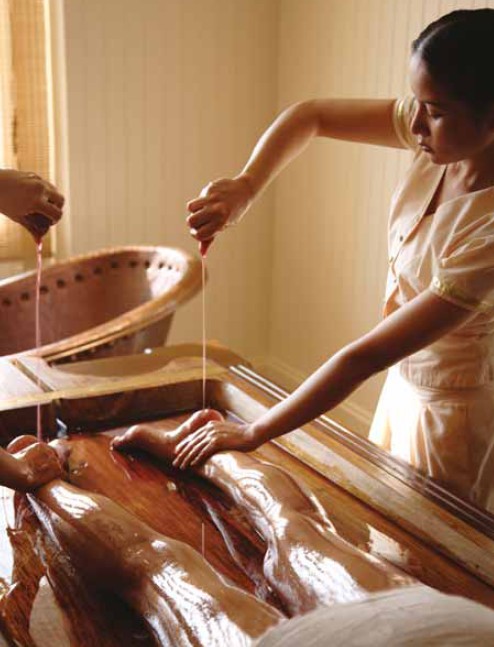

Abhyanga massage is traditionally performed by two, four or more therapists simultaneously and follows strict guidelines from Ayurvedic texts. Massage is first mentioned in the 6,000-year-old Atharva Upaveda, although was almost certainly practiced before this. Later, in the two major Ayurvedic treatises, the Charaka Samhita and the Sushruta Samhita, believed to have been written at the turn of the first millennium BC in Sanskrit verse, it is discussed in depth with exhaustive listings of positions of the body and measurements of oils, pastes and powders. In the Charaka Samhita, discussion of massage as a purification means to alter the chemical processes in cells is detailed and comprehensive. This comes in the chapter on panchakarma (see pages 46–49), whereby methods for the evacuation of toxins and the restoration of prana or cosmic energy to the body via lymphatic drainage are outlined. The Sushruta Samhita, on the other hand, is a treatise on surgery; it is here that methods of acupressure on the Meridian points, magnetism on the chakras and the positive spiritual and mental effects of massage are covered.
chavitti thirumal
Pressure Point Massage with Feet
Ayurvedic texts indicate that exercise, be it cardiovascular, involving stretching and breathing, or therapy, must be practiced on a daily basis for total wellbeing. Exercise is necessary to raise the metabolism, increase oxygenation, improve the function of the heart and circulatory system, and expel toxins.
For martial art and dance pupils, exercise and body conditioning are particularly important. In the past, pupils were taught (often individually) by gurus in what is known as the guru -shishya tradition; their education didn’t just include the one particular activity, but involved a thorough grounding in the classical texts, as well as such disciplines as yoga and pranayama. Nowadays, this tradition continues, but there are both residential and non-residential dance, drama and martial arts’ schools as well.
Kalari payattu gurrukal (master or teacher) Tomy Joseph stresses the importance of conditioning the body to stay in shape. “Gurrukal need to master both preventative and curative techniques too,” he notes. He says that chavitti thirumal, a very particular massage technique done with bare feet with the masseuse hanging from ropes tied to the ceiling, are mandatory for a gurrukal. Teachers routinely massage their pupils in this way to prepare the body for the stresses of the martial art, to maintain suppleness and to treat pain and swelling caused by combat.
The treatment is also given to those with neuro-muscular and skeletal disorders as well as to help clients reach beyond their psychophysical limitations. Based on a precise knowledge of the body’s energetic channels (nadis) and vital spots (marmas), the therapist suspends his weight from ropes overhead and applies pressure with long strokes of the soles of his feet, after the client’s body has been prepared with specially medicated oil. There is usually some manipulation of the joints and limbs also.
What distinguishes chavitti thirumal from other massage treatments is the application. The foot of the masseur is able to give a deeper, more thorough pressure and is able to cover the whole length of the body from the tips of the fingers to the tips of the toes, with long continuous graceful strokes. Therapists need to undergo many years of training: learning the chavitti art requires a certain type of calling and certainly a deep dedication to the wellbeing of clients and their physical, emotional, mental and spiritual upkeep.
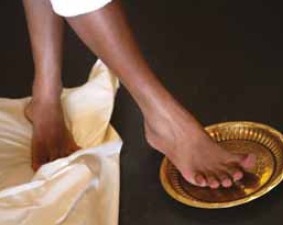
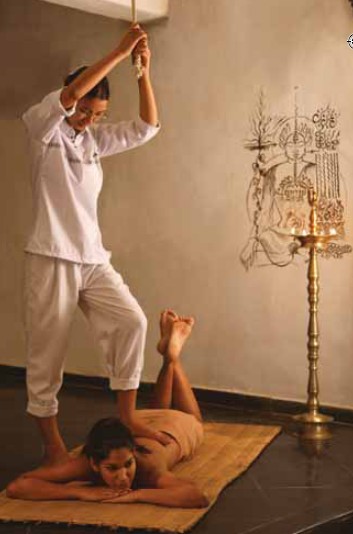
After placing a foot in some medicated oil, the chavitti therapist balances his or her weight via ropes hanging from the ceiling, and presses deep into marma points along the client’s back and legs.
hot stone abhyangam
This deeply penetrating, all-over body blast is an example of how Ayurveda may be integrated with other healing traditions from elsewhere in the world. Developed by therapists at the world-famous Soukya International Holistic Health Center near Bangalore, it employs the healing medicated herbal oils and massage movements of Ayurveda with the warmth and nurturing qualities of hot stones developed by both Native American Indians and Tibetans (separately of course!). It is one and a half hours of pure bliss.
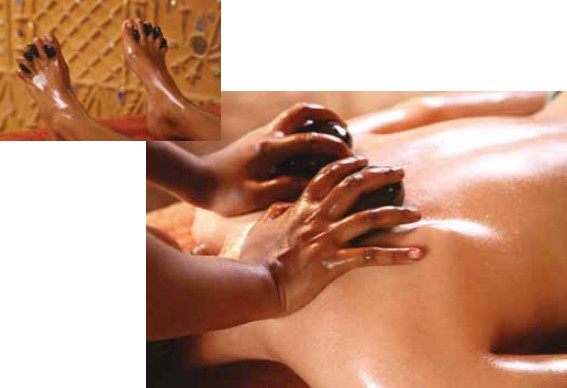
Small stones placed between the toes are delightfully indulgent, while larger ones are used for the massage itself. Feelings of warmth and security emanate from them; all the while the medicated oil does its detoxifying work.
There is both a therapeutic element and a feel-good factor to this treatment, so you can relax cocooned in the warmth emanating from the hot stones knowing that what is taking place is good for you. The long, firm strokes of the masseuse encourage the elimination of toxins from the deeper tissues and also stimulate peripheral circulation of both blood and lymph. This, along with the heat from the stones, enables the medicated oils to be absorbed to do their work. Naturally, as with all Ayurvedic treatments, oils are chosen according to the client’s constitution and/or ailment.
One therapist is in charge of heating and re-heating the stones, while the other alternates between oil massage, stone massage with oil, and placing stones at key points on the body. As the treatment progresses, a rhythm is established. One part of the body is being massaged, while a strategically placed stone sends heat deep into another part of the body; as the stone cools, it is replaced or taken away and another stone is placed elsewhere. After the back, legs and arms have been seen to, the client turns over, and is then invited to lie down on eight stones that run up either side of the spine. The heat is then twofold: coming up through the back, and down from stones on the front.
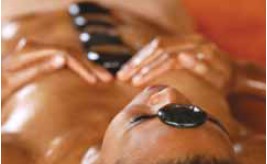
Stones are often basalt, a black volcanic rock with a high iron content, that absorbs and retains heat well. Such stones are believed to improve energy flows in the body.
With soothing music, firm massage strokes and the wonderfully nurturing warmth from the smooth stones, this is an experience to savor. The mind wanders and returns, the body sighs in acceptance, the spirit is soothed. Unfortunately, it seems all too soon when the treatment comes to an end. Nonetheless, the benefits linger and if this therapy is prescribed as a daily treat during a long-term stay, the effects are magnified considerably.
marma massage Pressure Point Massage
Indian pressure points are known as marmas and are similar to Chinese acupressure points. Translating from the Sanskrit as “secret” or “hidden”, they are found at junctures of the body where two or more tissues, muscles, veins, ligaments, bones or joints meet.
In Traditional Chinese Medicine (TCM), there are thousands of such points, but only 107 exist in the Ayurvedic system. Consisting of major points that correspond to the seven chakras and minor points that radiate out along the torso and limbs, they are measured by finger units (anguli) to detect their correct locations. There are 22 points on the lower extremities, 22 on the arms, 12 on the chest and stomach, 14 on the back and 37 on the head and neck. The mind is considered the 108th marma point. In the Sushruta Samhita each point has a Sanskrit name.
Ayurveda states that every marma point is placed at a junction of different channels of prana movements in the body. Prana, similar to chi in TCM, is considered the subtle vital energy that pervades every part of the body, nurturing the cell systems. If marma points become blocked or ruptured, prana flow is interrupted and organs may become diseased. If they are clear, prana is free to travel the meridians or nidas unchecked — and the body is healthy.
The idea of massaging the marma points began in Kerala at around 1500 BC when masters of kalari payattu first used the marma points as points for injury. It was only a matter of time before Ayurvedic physicians realized that these points could also be used for healing — and began to experiment with massaging the points to trigger a healing flow of energy. Today, marma massage is practiced at clinics and spas for a number of different reasons, be it therapeutic, relaxing or revitalizing.
Marma massage generally combines soft, flowing movements (abhyangam) with pressure point therapy. For the latter, the therapist uses one or more fingers depending on the size of the marma point, and either presses directly or in circular motions on that particular point. It is believed that clockwise movements stimulate and energize a marma point, while counterclockwise motions break up blocked energy and toxins held within a point. The practice is quite similar to Chinese acupressure or Japanese shiatsu, the origins of which lie in Ayurvedic practice. Benefits of regular marma massage are a general balancing — emotional, spiritual and physical — resulting in clarity, calmness and confidence.


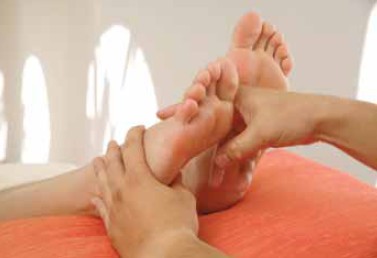
Showing both chakra points and meridians, this educational drawing (left below) shows how prana or the vital force needs to flow around the body. Specific points (left and below) are pressed to release blocked prana.
champi Indian Head Massage
In spite of its name, Indian head massage involves work not only on the head but on the upper back, shoulders, neck, scalp and face too. In much the same way that Traditional Chinese Medicine dictates that certain points on the feet are directly aligned to internal organs, Ayurvedic texts relate certain parts of the head to other body parts and/or symptoms or diseases. Therefore, a champi or head massage does not only affect the immediate areas massaged: it can be a healing, rejuvenating and thoroughly stimulating experience as well.
The moment a baby is born, the fontanel on the top of its head is covered immediately with cloth soaked in oil with a bala root decoction to strengthen the head, sight and intelligence. Mothers massage their babies’ heads to facilitate strong skull and brain development, and later, give their daughters head massages to stimulate the scalp and infuse conditioning oils into the hair. Men are used to receiving a sharp rubdown at the barber’s shop and another place you are likely to receive an Indian head massage is in a salon or spa.
The massage normally takes 30 to 60 minutes and is given seated in a chair. It may be dry or oils may be used to both condition hair and calm the nervous system, as hair roots are connected to nerve fibers. Techniques vary, but the therapist usually start by gently kneading upper back, shoulder and neck muscles, then works up to the head. Here, the scalp is squeezed, rubbed and tapped and hair may be combed or pulled. The therapist locates the marma points along the head and spends time tugging and pressing earlobes, before moving on to the face. Facial massage is usually a mixture of acupressure and gentle manipulation, ending with soft stroking.
People who suffer from vertigo, headaches, migraines, insomnia, tinnitus and depression are all reported to find champi helpful. As the therapist works on the three higher chakras, the vissuddha (the base of the throat), ajna (the forehead) and sahasrara (the crown), mental and emotional stress is immediately released. In addition, the localized massage improves the supply of glucose and blood to the brain, improves the circulation of cerebrospinal fluid, dissipates accumulated toxins and opens pranic channels. Results include improved memory, clarity of mind, better eyesight and concentration, and clearing of the sinuses.


The therapist at the Ayurvedic Penthouse at Mandarin Oriental in Bangkok, first prepares for a 60-minute Indian head massage session by creating an atmosphere of calm with candlelight and aromatic oil burners. Then, she starts the therapy with pressure point massage to stimulate the vital energy points in the skull, thereby increasing the flow of subtle energies in the body. The result is a client comforted, nurtured and relaxed.
udwarthanam Dry Massage with Herbal Powder
A stimulating massage that uses dry powders not oil, udwarthanam is vigorous, energizing and not for the faint hearted. Dry herbal powders, chosen according to one’s dosha, are rubbed into the skin in the opposite direction to hair growth with strong repeated movements. The friction of the powder during the massage creates body heat that increases circulation, breaks down cellulite, firms muscle tone and reduces fat by improving the metabolism of the muscles. It is recommended for those who want to lose weight, as it reduces cholesterol levels and adipose tissue and promotes better digestion and. It also removes toxins and exfoliates the skin, leaving skin tingling, soothed and soft.
Most Ayurvedic massages tend to use long, flowing strokes that go away from the heart and from bottom to top, but udwarthanam employs short, sharp superficial rubs that go in the opposite direction, away from the heart towards the extremities and from the top of the body downwards. This is the opposite of the dosha flow. According to Ayurvedic physician, Dr Ajitha of Soukya, the powder helps to open up the micro-channels in the body, so reduces fat accumulation, tautens up muscles, reduces bad body odor and exfoliates dead surface skin cells. In a clinical setting, udwarthanam is usually prescribed for 10 to 14 days for those with ama twan or slowness of flow in the channels, and as a means to reduce fat. However, the massage type is increasingly finding its way into spas and retreats, where its invigorating style is gaining popularity.
At the spa at Udaivilas, a beautiful resort on the shore of Lake Pichola in Udaipur, one of three Ayurvedic powders or choornam are used: the popular triphala choornam or three fruit powder, a powder composed from Terminalia chebula or Terminalia bellaruca, or kola kula thadhi choornam, made from a variety of pulses and herbs. The massage is quite rough and the powder enters the superficial bloodstream, but also enters nasally as it flies about in the air. This cleanses the internal system too. Afterwards, the client is encouraged to spend 10 minutes in the steam room and further massage any residual powder into the skin. As sweating occurs, toxins are released through the skin’s pores, and the skin is left feeling soft, extremely smooth and rejuvenated.
Another place that offers udwarthanam is Soukya International Holistic Health Center. Here it is prescribed for guests who are obese and the powders are prepared on site. They differ from patient to patient, but may contain vacha (Acorus calamus) to alleviate swelling, the Ayurvedic all-round wonder fruit amalaki or Indian Gooseberry (Emblica officinalis), green gram powder and/or basil. All the herbs are washed, cut into small pieces, dried and pulverized on site to make either a fine or coarse powder, which is then strewn on to the body and massaged in by two therapists simultaneously.
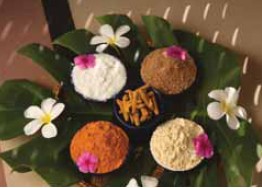
Some of the powders used at Udaivilas; they contain what doctors call madagna properties that reduce fat and help clear blockages.
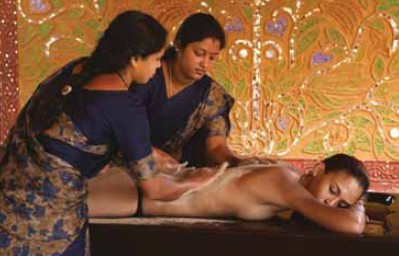
Two therapists at Soukya massage a client with powder made on site. Udwarthanam is also useful as a depilatory because the short, sharp rubs tend to pluck hairs from the roots.
sirodhara Oiling the Third Eye
Surprisingly, sirodhara is the most widespread Ayurvedic therapy offered at spas outside India. Why this is the case is unclear, as it is not prescribed for many ailments in a clinical environment. It invariably comes top of the Ayurvedic menu, and even spas without an Ayurvedic department offer bastardized versions. Many people have tried it, and even if they haven’t, they will almost certainly have heard of it.
Coming from siro (“head”) and dhara (“pouring of herbal liquids on specific body parts”), sirodhara denotes the continuous pouring of herbal oils, milk, buttermilk or ghee over the head and scalp. The patient lies on his or her back on a wooden treatment table, cocooned in warm towels, while a therapist trains a steady rhythmic stream of warm liquid from a perforated vessel made of clay, wood or metal on to the forehead. The table is made from one of seven therapeutic woods and is designed to catch the oil for recycling on the same client.
Oil stroking the “third eye” has a balancing effect on the deepest recesses of the brain and is profoundly relaxing. In Ayurveda, it is seen as a stimulating procedure for the nervous system and is prescribed for bringing down aggravated vata conditions such as insomnia, headache, insecurity, fear and nervous strain. Irritable pitta predominant people with overactive minds can experience a cooling, calming benefit from a session or two and kaphas often fall asleep. Used in conjunction with other therapies, sirodhara has been practiced for thousands of years to treat many and varied conditions such as ear, nose and throat disturbances, glandular problems, psychiatric disorders, hypertension, skin diseases, facial paralysis and more. During a session, the nervous system unwinds, busy brains become clear, and tired bodies are refreshed.
In a clinical environment, the choice of liquid and duration of treatment varies according to the individual. Vata patients are generally prescribed medicated herbal oil, pitta types receive herbal milk, ghee or coconut oil, and buttermilk is often recommended for kapha patients. Ancient texts denote 53 minutes for vatas, 43 minutes for pitas and 31 minutes for kaphas! It is suggested the best time to receive sirodhara is early in the morning for a period of 21 consecutive days, depending on the client. A variation of sirodhara is deha-dhara, where two to four therapists pour a continuous flow of oil over the entire body.
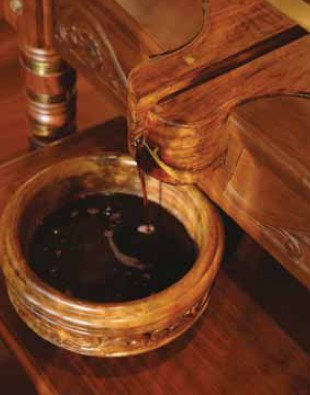


Beautifully carved beds are usually made from one piece of wood, often neem, and are designed so that oil flows through a drainage channel and is captured in a wooden bowl for re-use.

The Charaka Samhita specifies seven types of wood for an Ayurvedic bed or patti with the emphasis being on the wood having no joins. Because of the quality of the wood, beds are often works of art in themselves; often inlaid with copper or tin inserts, the more elaborate ones have evocative carvings as well.
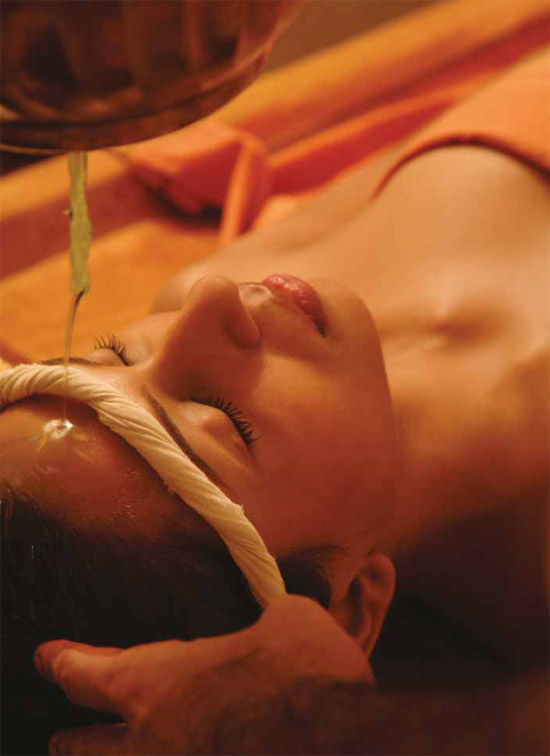
At Quan spa in the JW Marriott Mumbai, oil at a sirodhara session is forced to flow back over the forehead down to the bed with the fastening of a piece of cloth just below the “third eye”.

The palatial surrounds of Neemrana Fort Palace’s courts and halls are highly conducive to healing. Here, a therapist trains the flow of oil on to the forehead of a client.
vasthi The Medicated Enema
To most Westerners the subject of enemas is one to be avoided, at best; subjected to, at worst. This probably stems from an innate squeamishness, but, be that as it may, the insertion into the anus, urinary organs and genitals of various kinds of enemas such as water, medicated and nonmedicated oils and milks, and herbal decoctions is an integral part of Ayurvedic practice. This is because Ayurveda states that the status of the alimentary canal and other internal organs is of vital importance to one’s overall health.
Vasthi (basti) is the word for a medicated enema, and in Ayurveda vasthi involves the introduction of herbal and medicinal concoctions in a liquid medium into and also on to the body. Sites where vasthi may be administered therefore also include external areas such as the eyes, lower back, head and the chest region. It is believed that these medicinal vasthi remove wastes and toxins from the body (either internally or externally), balance the functions of the doshas, provide nourishment and raise the body’s mmunity.
Vasthi is most effective in the treatment of vata disorders, although many enemas over a prescribed period of time are usually required. There are different types of vasthi given for many vastly differing ailments, including constipation, chronic fever, cold, sexual disorders, kidney stones, heart pain, backache, sciatica and other pains in the joints. Many other vata disorders such as arthritis, rheumatism, gout, muscle spasms and headaches may also be treated with the varying vasthi.

After a doughnut-style mix of gram flour and water is placed on the lower back and deemed watertight, warmed medicated oil is poured into the “container”. It is left to seep into the client’s sacrolumbar region or “foment” as Ayurvedic physicians call it.

The nurturing Ayurvedic Penthouse at the Oriental Spa in Bangkok offers a number of vasthi treatments including hrid or uro vasthi, an effective therapy for complaints of the heart and respiratory organs. Warm medicated oil, chosen according to the client’s complaint and doshic imbalance, foments on the chest area for 40 minutes or so.
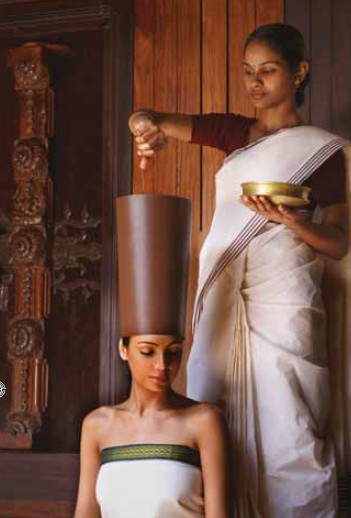
A Keralan therapist at the atmospheric Ayurmana facility at Kumarakom Lake Resort pours warm medicated oil on to the skull of a client. Prior to this therapy, which is thought to relieve stress and regulate brain function, it is recommended the head be shaved.
Vasthi is one of the five main procedures of the famous (or infamous) panchakarma therapy (see page 46), but it may also be used in localized areas for neck complaints (greva vasthi), knee joint conditions (janu vasthi) and heart disease or asthma and respiratory diseases (hrid or uro vasthi). In Indian spas, a couple of vasthi therapies are offered for one-off “try-outs”:
Siro Vasthi
Usually offered for conditions such as facial paralysis, depression, insomnia, dryness of nostrils, mouth and throat illnesses and severe headaches, siro vasthi is on some Indian spa menus as a relaxing, stress-relieving and hair-conditioning therapy. Siro vasthi (siro means “head”) involves the application of lukewarm herbal oils poured into a cap fitted on the head for any time between 15 to 60 minutes. The oils are left to stagnate on the scalp for the time required; according to one’s dosha, current imbalances and/or medical conditions, medicated herbs will have been added to the oil. An antioxidant medicated oil called dhan wantharam that contains 28 herbs and an earthy fragrance is often used as it has rich pain-relieving properties.
Kathi Vasthi
A vasthi treatment that concentrates on the sacro-lumbar region of the back (kathi), this is a curative treatment useful for lower back problems. It is also used for complaints that affect the abdomen, such as irritable bowel syndrome, endometriosis, menstrual and urinary tract disorders. It involves the pouring of warm medicated oil into an enclosed area of the lower back, created with a reservoir of dough (see right).
In some spas, kathi vasthi is used as a rejuvenative therapy to de-stress, relieve exhaustion or help with localized lower back pain. Providing the kathi vasthi is administered by a qualified Ayurvedic physician who has chosen the correct medicinal oil, a 20- to 60-minute session should not do any harm — and the gentle administering of warm, soothing oil on the back can be extremely pleasant.
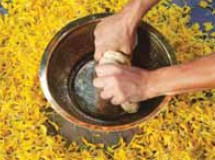

A therapist prepares a dough mixture, then places it on the back for a kathi vasthi session in the soothing surrounds of the Deva spa at Mandarin Oriental Dhara Devi in Chiang Mai, Thailand.
unani An Holistic Graeco-Arab Medical System
Although most spa-goers in the West will have heard of Ayurveda, they may not be so familiar with another branch of medicine known as Unani that is practiced extensively in India. Unani originated in Greece with the philosopher-physician Hippocrates (460–377 BC) and was formulated over time by various Islamic scholar physicians in what is now the Middle East. Noted Arab physicians such as Rhazes (850–925) and Avicenna (aka Ibn Sina 980–1037) further developed Unani and, by the European Middle Ages, it had became the authoritative basis for the study of medicine. It was instrumental in introducing professional standards of practice to medicine all over Europe.
Unani was introduced to India during the medieval period, and over time, mass acceptance and continuous use led to many Unani hospitals, research centers and clinics being built. Its heyday in India lasted from the 13th to the 17th centuries, as the Delhi Sultans, the Khiljis, the Tughlaqs and the Mughal emperors provided patronage to Unani scholars, often employing them as court physicians.
During this period, many drugs and herbs native to India were added to the existing apothecary of Unani remedies. Clinical trials and experimentation resulted in expansion, and even though Unani suffered setbacks during the colonial period, it had become entrenched in Indian life. Today, India has the largest number of educational, research and health care institutions of Unani medicine in the world with over 20,000 registered Unani practitioners (hakims) and countless non-registered ones who practice on a hereditary basis.
Unani is recognized by the World Health Organization (WHO) as a holistic traditional medical system. In 1977 when the WHO established its traditional medicine program, it declared: “There is no doubt that this branch of medicine is making and will continue to make a very significant contribution to our efforts to achieve health for all.”
Unani’s goal is the preservation of health, the encouragement of self-healing and the restoration of the body’s equilibrium. In its infancy it was a rigorous system that eliminated superstition and harmful folk practices, and as developments and discoveries were made, it added to its repertoire of remedies and practices. Nowadays, Unani practitioners combine herbal medical remedies with dietary advice, regimental therapy, psychological practices, surgery and spiritual discipline.
As with other holistic practices, a Unani hakim tends to look at the patient as a whole — mentally, physically, emotionally and spiritually — before prescribing a course of treatment. Dr Mathai of the integrative medicinal retreat called Soukya explains: “Unani aims to promote positive health and prevent diseases and is based around six essentials: good air and water, a balanced diet, exercise and rest, psychic movement and rest, sleep and wakefulness, and evacuation and retention. Remedies are usually herbal, although ingredients of animal, marine and mineral origin are used. Humoral theory (the presence and balance of blood, phlegm, yellow bile and black bile) is at its heart, and the temperament of a person is accordingly expressed by Sanguine, Phlegmatic, Choleric and Melancholic. According to Unani theories, any change in these humors brings about changes in the status of health of a human body.”

A copy of the Makhzani-Hikmat or The Family Doctor and Hakeem: An Encyclopaedia of Domestic Medicine and Surgery by Dr H Ghulam Jilani in Urdu. It is open on a page that deals with medication for migraine.
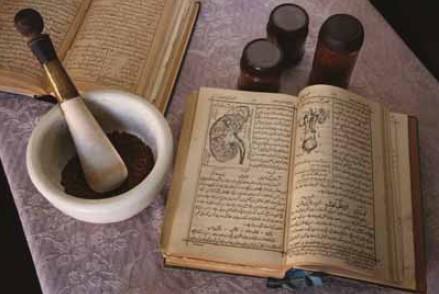
All Unani medicines are made from 100 percent natural ingredients including plants, herbs and minerals. This mufaras or medicine made by Hakim Sayed Riazuddin in Mysore contains musk, amber, silver, gold and zafaran leaf. It is reputed to be helpful for excessive palpitation of the heart.

A Unani application used on the skin to help with white pigmentation marks. Made at Soukya mainly from bakuchi or Psoralea corylifolia seeds, it is anti-fungal and anti-protozoal. Repeated applications over a period of time result in a gradual fading of the discoloration.
Many herbal preparations in India are as likely to be Unani in origin as they are Ayurvedic, as historically the two overlap significantly. Unani herbology is well documented and spa treatments such as body polishes and wraps often use ingredients from the Unani pharmacopoeia. There are a number of pastes, formulated from fresh herbs, seeds and roots, suitable for ailments such as vitiligo, eczema, psoriasis, bronchial asthma and arthritis. This is good news for sufferers, as many such ailments do not have a cure in Western medicine.
A case in point is a thick herbal paste used at Soukya to reduce skin pigmentation or leucoderma. Psoralea corylifolia seeds are boiled in milk, then dried (not in direct sunlight), with the process being repeated seven times in total. Afterwards, the mix is ground into a powder, some other ingredients are added and a little bit of water makes it into a paste. Over a period of a month, the paste is applied on to the specific areas of the skin daily for 20 to 45 minutes and the area held in direct sunlight. Afterwards, it is washed off. Patients report a diminishing of the bright white spots with time. However, as with Ayurvedic remedies, there is no quick fix!
siddha Tamil Herbal Healing
Perhaps not so well known outside India as Ayurveda, Siddha is an ancient form of natural medicine that has been practiced in Tamil Nadu for centuries. Taking its name from 18 Tamil siddhars (devotees of Shiva who attained siddhi or perfection), it shares with Ayurveda the theory of five elements and three doshas, which are referred to as muppini in Tamil. However, unlike Ayurveda, Siddha divides the body according to the five elements. So, earth corresponds to the legs, water to the abdomen, fire to the chest, air to the neck and space to the head. It also relates the five elements to bodily fluids.
The fundamental principles of Siddha medicine are encapsulated in several Tamil texts. Like all Hindu philosophers, the siddhars believed, that all life should seek oneness with God, so a productive long life was to be encouraged. Their basic premise was that the universe consists of two essential entities — matter and energy — that are found in five primordial elements: munn (solids), neer (fluids), thee (radiance), vayu (gas) and aakasam (ether). If these elements are maintained in equilibrium, the result is health; if there is disruption, the result is disease.
Alchemical ideas dominate Siddha medicine, with its materia medica consisting of herbs, roots, salts, metals and mineral compounds. The 18 siddhars classified 4,448 diseases and prescribed medicines accordingly. Nevertheless, bhasmas (fine powders made from incinerated and purified metals and minerals) are at the forefront of their prescriptions. However, as with Ayurveda, other common preparations include choornam (powders), kashayam (decoctions), lehyam (confections), gritham (ghee preparations) and tailam (oils). Siddha specialities are chunna (metallic preparations that become alkaline after purification), mezhugu (waxy preparations) and kattu (preparations that are impervious to water and fire). The medicines are generally taken internally, although there are some external applications also.
The Siddha system includes not only medicine and alchemy but also yoga and philosophy. Diet is an important part of Siddha, as doctors identify and associate different food types with different doshas, and the pursuit of longevity without illness and a useful, spiritual life is its ultimate aim. The spiritual aspect of healing, wellness and being at one with the Divine cannot be under-emphasized: it lies at the heart of all Siddha discipline.
It is not often that visitors to India come across Siddha practices outside Tamil Nadu, but sometimes you will be lucky. Aura spas at the forward-looking Park Hotels offer a type of marma massage prescribed mainly for rheumatics that dates from pre-Vedic times in Siddha culture. Using medicated herbal oils it targets the marma points to release stored emotions in order to restore mental, emotional and spiritual equilibrium. Each point is related to a particular concept: for example, shoulder points store emotions of responsibility and sternum points relate to the heart, so the masseur concentrates on different areas for different effects. It is an extremely powerful treatment that sometimes results in intense emotional outpouring and tension release.

A Siddha preparation made at Soukya from neem leaves and turmeric used as an external paste in the treatment of psoriasis.

A selection of minerals in raw, incinerated, semi-cooked and purified form, all used in Siddha formulations. They include iron, mercury, arsenic and sulphur.

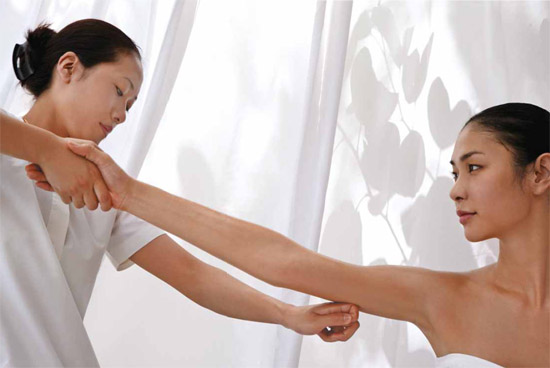
The photos on these two pages show various pressure positions given in a type of marma massage that dates back to pre-Vedic times in Siddha culture. Using medicated herbal oils, it was prescribed mainly for rheumatics. Here, it has been resurrected at Aura spas in the forward-thinking Park Hotels. “The 107 marma points are targeted to release stored emotions in order to restore mental, emotional and spiritual equilibrium,” explains spa director Megha Dinesh. “Each point is related to a particular concept: ie the knee is related to death, that’s why so many older people get arthritis in the knee. Shoulder points store the emotions of responsibility and the sternum points are related to the heart, so people with hunched shoulders may be loveless.” She goes on to add that the treatment is very powerful and can have long-lasting effects especially if particular areas are targeted for very specific results.

Therapists tend to use elbows and knuckles as well as the palm of the hand when targeting particular marma points. It’s believed that pranic flow can become blocked, so pressure at such points helps release the vital force; at the same time pent-up emotions may be subconsciously released too. It’s reported that clients often have intense reactions to this treatment, so it should not be undertaken lightly.
soba rig-pa
Traditional Tibetan Medicine
Tibetan medicine is a traditional system of medicine that has been practiced for over 2,500 years and is still practiced today both within Tibet and by Tibetans in exile. Called Soba Rig-pa or the “Science of Healing”, it uses many natural ingredients including herbs, trees, rocks, resins, soils, precious metals and more. However, 95 percent of Tibetan medicine is based on herbs, and precious metals are used for the seven kinds of precious pill known as rinchen rilpo.
Soba Rig-pa’s basic premise is that the body needs to be balanced to be well. When imbalances in what are called the three humors or nyipa sum (rLung, mKhris-pa and Bad-kan) occur, a person falls ill; symptoms may be physical, mental, spiritual or a combination of all three. In brief, rLung is the subtle flow of energy in the body; mKhris-pa is the hot nature or bile within the body; and Bad-kan is concerned with the body’s cold nature signified by phlegm. Attachment, Aversion and Delusion are considered long-term causes of balance, whereas in the short-term, imbalances may be caused by time, temperature and season, the influence of spirits, improper diet and improper behavior.
After diagnosis, Tibetan doctors offer four types of prescription: behavioral suggestions, a medical prescription, diet advice, or surgery. As with other holistic systems of medicine, physical therapies are only part of a doctor’s prescription. Based on the centuries-old Buddhist study of the mind, Tibetan medicine gives priority to factors of psychological and spiritual development as well.
Today, a limited number of spas offer a few Tibetan physical therapies that have been formulated over the centuries. A case in point is CHI spas at Shangri-La hotels found all over Asia: There, spa personnel have formulated some Himalayan therapies that are probably the closest you will get to an authentic Tibetan treatment outside a Tibetan clinic.
Healing Stone Massage
Described in Tibet’s medical bible, the Gui Shi, massage with stones has all but died out in Tibet, only being practiced in the most remote and wild borderlands of the Tibetan plateau. As Tibetans are traditionally nomads, their therapies contain influences from many different sources, this profound practice being no exception. It was probably introduced to Tibet from Mongols that settled in the Hor region around Lake Kokonor; in its pure form, it uses heated stones that have been “cooked” in the bellies of sheep.
In the spa, the therapy combines the Mongolian concept of healing through stones; principles and techniques of Ayurveda that traveled up the Indian trade routes over Himalayan passes; pressure point techniques from Traditional Chinese Medicine; and Tibetan healing intent (imbuing the stones with awareness through visualization). The application of water-heated Himalayan river stones to key points on the body relaxes muscles, allowing manipulation of a greater intensity than regular massage. Blood vessels expand, pushing blood and waste materials through the body. This has a strengthening and sedative effect on the nervous system, and relieves anxiety and stress. On a physical level, it provides relief to sore muscles and fosters deep muscle manipulation, all the time improving circulation and removing toxins from the body. On a mental level, it is nurturing and comforting.


In Mongolia, stones and minerals are commonly used both internally and externally for various ailments. It is believed that when hot stones are applied to specific points on the body they help dispel blockages, enabling the smooth flow of chi or life force energy through the body. These stones have been carved with Sanskrit symbols by Buddhist monks and are used in the CHI spa hot stone massage at Shangri-La hotels.
Mountain Tsampa Rub
The second CHI treatment we focus on combines tsampa with ancient Tibetan massage techniques and transforms them into a powerful detoxifying and cleansing treatment. Tsampa is roast flour, most commonly of barley, and is the staple foodstuff of Tibetans. Most Tibetans used to live (and many still do) on the high Tibetan plateau, where harsh conditions, thin air and a definite lack of resources result in a scarcity of food. Tsampa mixed with butter tea (tea flavored with salty yak butter) has historically been a life saver, giving energy and sustenance year round. Here, the flour is used as the postscript to the treatment.
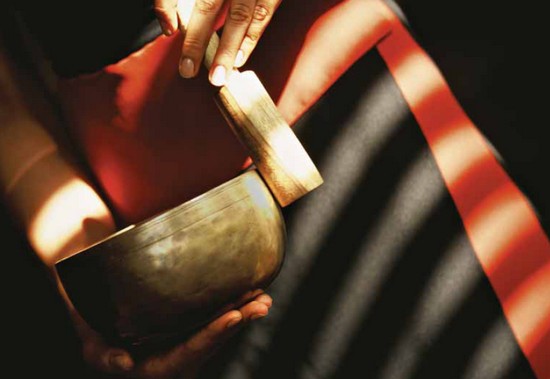
Tibetan singing bowls, often used in monasteries as aids for meditation, are rung before a treatment at CHI spas.

A thangka painting, one of a set of 79 illustrations of the Tibetan medical system, demonstrating diagnosis, treatments and cures.
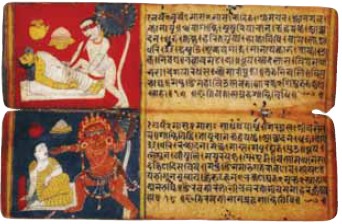
Unlike Indian texts, this old Tibetan medical text has colorful illustrations depicting both healing and illness.
Unlike acupressure or the Chinese style of massage, Tibetan massage works on the “wind” channels of the body — those that deal with the circulation of energy, blood and lymph. Generally, massage techniques include stroking (long, longitudinal strokes or effleurage), rubbing with vigorous circular motions to create friction, and kneading. The aim is to increase lymphatic drainage and blood circulation in order to aid muscle nutrition, reduce stiffness in joints, improve flexibility and heighten body awareness.
The initial part of this treatment comprises an invigorating massage combined with powerful lymph draining herbal oils to drain the lymph system; this helps to refresh and uplift the client, restoring energy and chi. As in Ayurveda, the herbs infused into the oils are just as important as the techniques used in application. Particular focus is given to specific energy points on the body to help the oils penetrate into the skin and awaken chi.
The second part of the treatment is considerably gentler and more relaxing. A blend of tsampa flour and powerful lymph draining herbs is applied all over the body to absorb excess oil and toxins that have come up to the surface of the skin. Rubbing the tsampa herb blend into the skin leaves the skin soft, gently exfoliated and free of inner toxins.
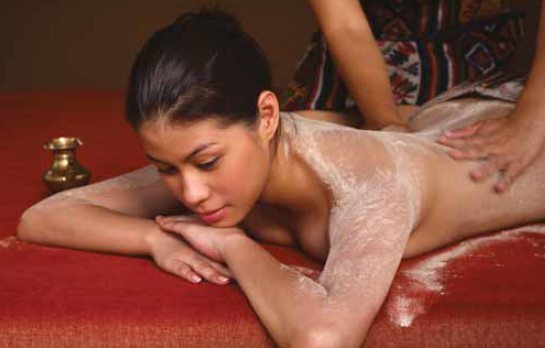
A tsampa mix applied to the back is massaged in to drain toxins out from the lymphatic system.
panchakarma
Ayurvedic Revitalization
Traditionally undertaken during the monsoon season when herbs have been newly harvested and skin is most receptive to oil, the purging panchakarma treatment is an annual event in many Indians’ lives. According to the Ashtanga Hridaya, it “leads to clarity of intellect, power to the organs, elemental stability and glow to digestive fire” and it delays aging if it is properly carried out.
Offered at many Ayurvedic hospitals, homestays and retreats as a stand-alone rejuvenation and detoxification treatment, panchakarma is really one part of a group of therapies belonging to a class of cleansing procedures called shodhana. Clients are given an individual program of medication, diet and treatments after an intensive consultation with a physician, and are monitored throughout the two to six week program. However, regardless of the panchakarma prescription, there are always three basic procedures: Purvakarma or preparation, pradhanakarma or treatments and paschatkarma, post-treatment care.
At Kalari Kovilakom, an Ayurvedic retreat situated in a palace estate in the Annamalai foothills in Kerala, the preparatory procedures take from three days to a week: They are designed to help the body discard toxins present in the stomach and tissues and help facilitate their movement to the alimentary canal. “This stage often includes special internal medicines and snehanan or oleation therapy and swedanam or sweat therapy,” explains Dr Jayan. “The latter may take the form of the application of warm oil over the body and the application of heated pouches of herbs on the body, but each patient is different, with different dosha imbalances, so the treatments always vary.”
When the body and mind are deemed ready, pradhanakarma or the main treatment designed to each individual’s needs, begins. As its name suggests (panch means “five” and karma means “action”), the process comprises five cleansing procedures, each designed to correct doshic imbalances. They are vamanam or induced vomiting, allegedly a painless, drug-induced emetic process; virechanam or induced purgation, whereby drugs that stimulate bowel movements are taken internally; vasthi, the use of medicated enemas (see pages 32–35); nasyam or nasal cleansing through the application of medical oils or powders (see right); and rakthamoksham or detoxification of the blood.
Clearly, this therapy is not for the faint-hearted, and the patient/doctor level of trust needs to be very high. This is why Kalari Kovilakom insists on a minimum stay of 14 days, so that doctors can truly assess and monitor a patient’s needs. Dr Jayan explains that rarely are all five therapies prescribed. “For pitta imbalances, we prescribe purgation with oils or powders, vata imbalances go the herbal and oil enema route, and kapha imbalances are always prescribed vamanam. Here patients drink two liters of milk or sugar cane juice mixed with special herbal medicines to induce vomiting after 45 minutes.” He goes on to say that nasyam is included if there are nasal, throat or brain problems and bloodletting is useful for skin problems. Hence, a patient may be prescribed only one of the five processes; sometimes two or three, and in rare cases, five.

A nasyam session at Ayurmana illustrates how a therapist pours medication into the nostrils. Ghee, choornam or powders, or medicated oils are used.
Naturally, the strict routine and caring staff at Kalari Kovilakom go a long way to supporting guests on this somewhat gruesome journey; nevertheless, many first-timers to the process describe both physical symptoms of discomfort and mental anguish. It is believed, however, that a special diet and medication, sessions of meditation and yoga and an unchanging routine provide the support network needed. Similarly, post-treatment after the guest leaves the premises in the form of medication, contact with doctors, rest and diet is highly recommended.
Ayurveda, from time immemorial, has focused on anti-aging and rejuvenation programs to prevent disease and to maintain an optimum healthy state. In today’s world, curative therapies are increasingly replacing preventative ones — and panchakarma (both curative and preventative) is one of the more extreme examples on the Ayurvedic menu. Nevertheless, devotees with the stamina and the will swear by it, and if the venue is carefully chosen, it may turn out to be a life-changing experience.

Ayurvedic powders and oils used in the panchakarma treatment at Kalari Kovilakom, a retreat in Kerala. The kizhi pouches are for the preparation stage, while the tray with the oil lamp is used to bless the patient before any therapy commences.
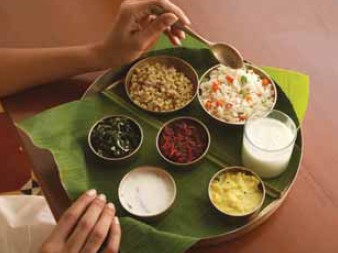
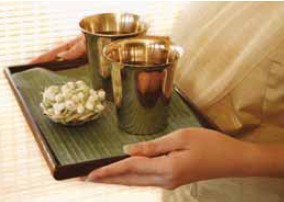
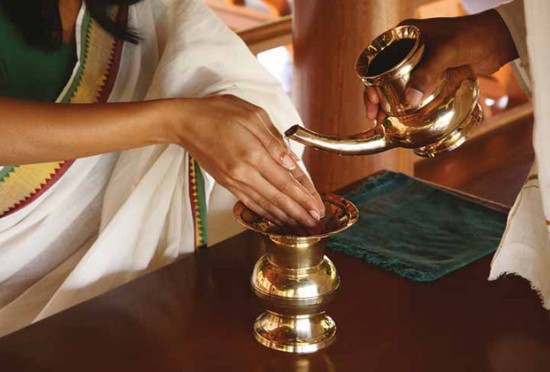
Proper diet is considered an important part of the healing process in panchakarma. At Kalari Kovilakom all food is prepared according to Ayurvedic principles with only copper, bell metal, earthenware, stone or brass vessels used in preparation, cooking and serving. Every patient has a special drink on hand 24 hours a day and meals are served in gleaming brass katories (cups) on a banana leaf covered thali tray.
mud therapy

Used on the face, mud draws out toxins very quickly, so it makes for an effective face mask. It may also be used on the eyes (but only in a pack) to strengthen the optic nerve and muscles, relax the eyes, and impart a cooling and de-stressing effect on the entire eye area.
In India, mud therapy falls under the Naturopathy umbrella, as it employs one of the Five Great Elements or Panchmahabhutas (panch is “five”, maha is “great”, bhuta is “element”). Comprising Earth, Water, Fire, Air and Ether, mud therapy unsurprisingly utilizes Earth as its main healing ingredient. Mud absorbs, dissolves and eliminates toxins from beneath the skin’s surface, opens the pores and improves peripheral blood circulation. As such, it is rejuvenating for the body and soothing for the skin.
Mud therapy is employed in the treatment of a variety of ailments such as digestive disorders, skin diseases and more. The world-famous Multani mitti or “mud from Multan”, an area now in Pakistan, was one of the earliest substances to be used as a beauty mask. This lime-rich clay was mixed with rice bran and milk or curd and used as a face pack to draw out toxins and polluting free radicals. Indeed, it is still used as such today. Because of its high mineral content and moisturizing effect, it is a great nourisher and often acts as a conduit for healing ingredients to be absorbed into the system. Ayurvedic texts record that mud draws out heat and excess pitta through the skin; it also says that Multani mitti can be used by all three doshas.
At Soukya, the integrated wellness center near Bangalore where Naturopathy is combined with other modalities to create individual therapeutic programs, mud is used in three ways: as a localized application, as a pack and as a full mud bath. Mud is harvested from the many ant hills found on site; as the ants have taken the mud from deep down, it’s incredibly pure without any surface pollutants. Therapists further prepare it by sieving it, washing it properly, and sterilizing it by drying it in sunlight. It is then stored carefully in airtight containers.
“Mud is healing in itself,” explains the resident naturopath Dr Usha Devi. “It has the property of retaining temperature for a long time, so depending on the ailment, can be applied either hot or cold.” Hot mud is used for joint conditions such as arthritis and to reduce oedema or water retention in localized areas of the body, and cold mud helps in the treatment of skin diseases, such as psoriasis for example.
Sometimes, herbs may be added such as disinfecting neem and turmeric if there is a possibility of infection and castor oil may be added to an abdominal pack in liver conditions. It helps stimulate the circulation of blood towards the liver, thereby aiding in the detoxification process.
Whichever mud therapy is assigned, the feeling is nurturing and strengthening. The tightening experienced when the mud dries on the skin is pleasant — be it hot or cold — and as it is straight from nature, you can be sure it is doing good work. The full mud bath is particularly invigorating: being slathered in soft, creamy mud, then having it washed off afterwards is a self-indulgent treat. The skin feels soft, smooth, tight and tingly afterwards — and there is no need for extra moisturizing.

Application of mud from top to toe may sound a bit messy (gross even), but it is an invigorating experience especially if the body is wrapped in a blanket after application. Micro elements from the mud are absorbed into the body and toxins expelled leaving skin and internal organs refreshed.
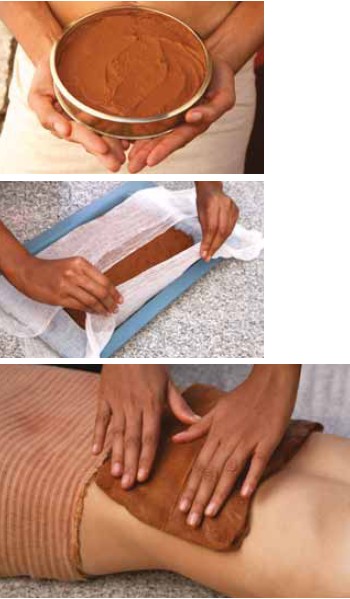
Mud from Soukya’s organic site is harvested, mixed with pure water and made into packs for a variety of uses. When placed on the abdomen, it is left for 20 minutes to improve digestion, strengthen the metabolism of the liver, prevent constipation and speed up blood circulation to the internal organs. Full of elements such as iron, manganese, zinc, copper, chromium and cobalt, it is therapeutic in the extreme.
ksheera dhooma
Medicated Milk Steam
A particular Ayurvedic method unique to Kerala, ksheera dhooma is prescribed for patients with facial palsy, certain nervous disorders, difficulty in voice and speech, headaches and trigeminal neuralgia (the trigeminal nerve is a cranial nerve that supplies the face). The word ksheera translates as “milk” and dhooma indicates a “fomentation by vapor”. Generally given to the face, although the steam may be directed to other parts of the body suffering from different conditions, it consists of a steaming with medicated milk. It is considered a treatment for vata related disorders.
First of all, a selection of herbs is boiled up with cow’s milk, then the steam issuing from the mix is passed through a tube to the affected area of the body (this has first been oiled with medicated herbal oil chosen according to the body’s constitution and condition). The steam makes what is known in Ayurvedic circles as a fomentation on the face, thereby allowing medicinal properties to be absorbed. The idea is to stimulate nerve endings and open up the micro-channels just below the skin’s surface.
At Soukya International Holistic Health Center, the medicated milk is steamed through a papaya stalk onto the chosen area. This allows the properties of the herbs and the milk to mix with papain, the active enzyme in papaya, before it reaches its destination. Papain is helpful in loosening and dissolving the top layer of dead skin cells, so, in this case, it helps prepare the skin for the absorption of the medicated herbs. The treatment is prescribed once a day for three, five or seven days consecutively and may be offered in combination with other treatments. It’s a good example of a traditional therapy offered in modern surrounds.

A therapist directs steam from boiling medicated milk on to the face of a patient at the integrated wellness center called Soukya. Known as a swedan (fomentation) therapy, ksheera dhooma is traditionally prescribed for people with vata related disorders (any muscle, ligament, joint or nerve-related disorder).
netra tarpanam
Vasthi Therapy for the Eyes
At an Ayurveda clinic, netra tarpanam is seen as an oral eye care treatment to help with eye strain, dryness of eyes, poor sight and other eye-related conditions. It is believed to strengthen the muscles round the eyes, cool the eyes, oleate the area round the eyes and may even help with myopia. As with all Ayurvedic prescriptions, at least a two-week course is suggested, and during the course of the treatment the patient should not be exposed to harsh light.
The treatment uses the medium of ghee or gritham, a type of clarified butter that is used all over India in cooking. “Ghee has what we call samskarika anuvarthana in Sanskrit,” explains Ayurvedic doctor, Dr Yogesh, “this means it has the specific quality of being able to absorb properties of herbal products and transfer them into the skin.” Depending on the condition, triphala gritham, good for the eyesight, or jeevanthyadhi gritham, a ghee that helps develop immunity, may be used.
To keep the ghee in place over the eye socket, a dough of black or green gram flour paste (gram powder mixed with water) is made and stuck around both eye cavities. A small amount of ghee melted to room temperature is then poured into the watertight enclosure, so that it fills the contained area and makes the eyelashes sink shut. The ghee is kept on the eyes for 20 minutes, during which time the patient is encouraged to move the eyes around.
It is a slightly fiddly process, and may not be for everybody. Some people experience a burning sensation when the medicated ghee is poured in, and having to hold still for a long time isn’t to every body’s liking.
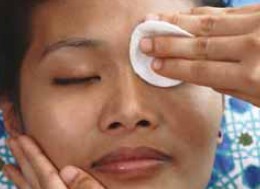
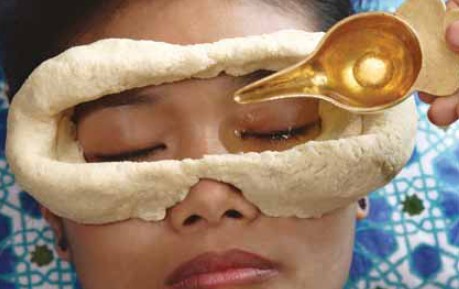
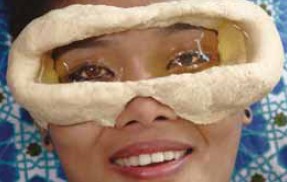
Strictly speaking, netra tarpanam is a vasthi therapy (see pages 32–35), as medicated ghee is kept trapped on a topical area in a watertight “reservoir” of dough. Whilst the ghee rests in its place, eyes should be rolled around, opened and closed, thereby allowing the ghee’s properties to be fully absorbed.
kizhi therapy
The Hot Herbal Pouch
In Ayurveda, the herbal poultice is a time-honored tradition of healing with heat. Packed with goodness, warmed pouches of herbs, plants, roots, and more, have been applied to sore, sprained or sad bodies for centuries. Classified as a swedanam (Sanskrit for sweat therapy) in the Vedic texts, the herbal poultice is both detoxifying and healing. Specially selected ingredients are tied tightly in natural cloth, steamed for a few minutes, then dipped in medicated herbal oil and applied to the body. On application, the heat induces sweating, thereby helping to bring toxins to the surface of the skin; then, once the pores are open, skin absorbs the properties of the herbs for healing.
The kizhi (Mahalayam word for bundle) has proved so popular over the centuries, its fame has spread to other cultures too. Many South East Asian herbal healthcare practices rely on the herbal poultice to relieve sore muscles and joint pains, while in India, hospitals, homestays, spas, wellness centers and salons offer various forms both as a stand-alone treatment or in conjunction with another therapy such as massage. The content, method of application and usage varies widely.
Patrapotlaswedanam
The Sanskrit name for this ancient Ayurvedic treatment is taken from patra meaning “leaves”, potla translating as “pouch” and swedanam meaning “fomentation” or “sweat therapy”. The integrated medical center called Soukya, just outside Bangalore, is known for its extensive herb gardens — so their potla makes full use of plants grown on site.
Leaves from the castor oil plant (Ricinus communis), rich in oil, are combined with Datura alba leaves (this plant is widely used by Ayurvedic and Siddha practitioners in oil-based preparations for dressings on wounds), skin tonifying nirgundi or Vitex nigundo leaves, and leaves from the moringo or drumstick tree. These latter leaves are a well-known natural antibiotic. In fact, all these leaves contain anti-inflammatory and pain-reducing properties, so are useful in arthritic conditions. To prepare the potla, they are washed, torn up and mixed with crushed garlic, lime and shredded coconut flesh, then fried with medicated oil in a wok, before being knotted up into small pouches.


Sand, like clay and mud, has the ability to retain heat or cold, so is an ideal filler for a heated compress. When dipped in warm, medicated oil, these bundles of goodness spread warmth and healing deep into tense or knotted muscles. At the tranquil Spa Village in the Pangkor Island Resort in Malaysia, pretty batik cottons are used to further the pouch’s appeal.
At Soukya, patients who have been prescribed this therapy are on a course of seven to 21 days, and the pouch is combined with other therapies. It may be given to people with sciatica, disc prolapse or lower back pain, and is usually applied after an external massage with medicated oil. Two therapists administer the potla: one warms two of the pouches in medicated oil, while the other massages the other two on to affected areas. Movements include gentle thudding and rubbing away from the heart.
Navara Kizhi
Definitely worth a try is the intriguingly named Navara kizhi, a Keralan treatment offered at many spas and clinics throughout India. At Oberoi Spa at Udaivilas, Navara rice (a type of dehusked, red rice) is mixed with milk and a decoction of bala root (Sida cordifolia) and boiled for half an hour until it achieves a gruel-like consistency. It is then wrapped into a loosely spun cotton cloth that allows the mixture to come through easily, and applied on to the body. The excess liquid is kept in a reserve pan on a warmer, so that the pouches may be periodically re-warmed.
Bala root is a powerful cell nourishing and regenerating herb, and is used in many Ayurvedic treatments to maintain youth and vitality. It means “youth” in Sanskrit, and is considered analgesic, diuretic and stimulating as well. When mixed with Navara rice and milk, the properties “go quite deep”, according to Ayurvedic doctor, Dr Yogesh, who recommends the treatment to develop muscles and improve muscle tone. “The pouch nourishes the skin, alleviates vata problems, improves blood circulation, reduces stiffness and strengthens both the quantity and quality of the muscles,” he says.
Variations on the Navara kizhi include podi kizhi (podi means “powder”; triphala or dashmool are often used); dhanya kizhi (dhanyam translates as “grains”, so a combination of processed grains is used here; naranga kizhi using a cloth pouch filled with lemon and herbs dipped in medicated oils; and elakizhi (ela means “leaves”. All are designed to act as a potent anti-rheumatic, so are helpful for stiffness in the joints.
The spa at Amanbagh uses dashmool powder (das means ten, mool translates as roots) in its specialized kizhi treatment. Tied securely in immaculate linen pouches, the pretty little bundles are dipped into warmed, medicated sesame first boiled with handpicked aak leaves (Calotropis gigantea) before application. Aak is a plant in the milkweed family that grows profusely in the immediate locality; known as swallow-wort, aak is useful in the treatment of paralysis, swellings and fever, and it is anti-inflammatory when applied externally.
The Sand Bundle
At the spa at Rajvilas and Spa Village spas in South East Asia, fomentation with small linen pouches filled with sand are the norm. The sand bundle is classified under ushema swedanam therapies, which translates as “to warm up (bundles) to sweat”.
At Rajvilas, sulphur sand from Simla (it can hold its temperature for a long time) is tied in small linen pouches, which are then dipped in warm medicated oil chosen according to one’s dosha and pounded on the body. Accompanied by massage, the therapy is soothing for inflammatory conditions, stiffness of joints and aching muscles; it also promotes general wellbeing. The heat speeds up blood circulation and promotes sweating, which in turn helps to eliminate toxins from the body.

Plucked from the organic garden, Soukya’s leaves are washed and chopped, then mixed with lime, coconut and garlic and fried in a wok with medicated oil chosen according to a patient’s health status and dosha imbalance. After frying for 10 to 15 minutes, the ingredients are transferred into soft cotton pouches, before being administered, wonderfully warmed in oil, on problem areas.

The gorgeous property in Udaipur known as Udaivilas not only boasts tranquil surrounds on Lake Pichola, it offers numerous sites for therapy. Built to resemble a Mewari palace, scallop-edged arches, jaali windows, cool sandstone and marble decorations, as well as abundant gardens, offer a delightful backdrop to a spa suite.